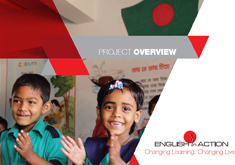EIA works closely with the Ministry of Primary and Mass Education and the Ministry of Education, as a discrete project under the Primary Education Development Programme III. Together we aim to enable good practice in English teaching and the development of English teachers, as promoted and demonstrated by EIA, to be introduced at even greater scale and to be sustained for future generations of children.
Our priorities for spreading and sustaining improvements in English teaching and learning are:
- The integration of effective approaches in new upcoming sector-wide programmes.
- The integration of student and teacher audio-visual materials into national curriculum materials.
- The effective implementation of EIA approaches with over 35,000 teachers and 4.5M students in 2015 and 2016.
Successes to date include:
- EIA is featured in the updated Primary Education Development Programme III plan and participated in the Joint Annual Review Mission in May 2015.
- EIA is part of the Secondary Education Sector Investment Programme national teacher education plan.
- EIA contents have been integrated into Government Subject Based Training (SBT) for English through participation in a joint Directorate of Primary Education - EIA Core Working Group.
- EIA secondary student and teacher audio-visual materials are now available on the National Curriculum and Textbook Board website.
- In Upazilas where EIA has worked, 2 out of 3 Government English SBT Teacher Trainers are now EIA teachers.
- 11 Upazilas have asked to participate in EIA in 2015 on their own initiative
- EIA materials have been oriented and disseminated in the curriculum dissemination training to the Master trainers and key trainers as well; gradually these will go to the Teacher Trainer and the teachers also.
- Moreover EIA was involved with NCTB for developing Continuous Assessment tools for primary, where EIA approaches and materials are integrated to assess language skills from class 1 to 5.
However, there is still a long journey ahead to make sure that what has been started over the past years becomes ¬firmly embedded inside Government systems and programmes. The Government of Bangladesh and EIA are working ever more closely to achieve this goal.






